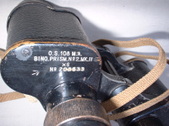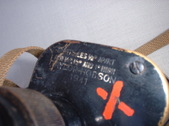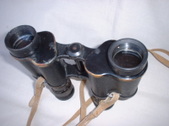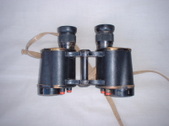Note: After you click on images to ENLARGE them, you may find they automatically size smaller in your browser's window making them harder to view. The auto sizing is your browser's way of keeping images entirely within the screen size you have set. Move your mouse pointer to the bottom centre of the pic and you will see an options panel appear. There will be a small square box next to the large X, which will have a pointer arrow sticking out of it. If it's illuminated, it means the pic you're viewing can be enlarged, so click on this box and the pic will EXPAND and open to its normal size. You can then grab the pic with your mouse (hold down left mouse button) and move it around to look more closely at various parts of the photo.
Looking to complete your No4 or L42 CES?
(by Peter Laidler)
(by Peter Laidler)
BINOCULARS
By now, most of you will know that the CES, the Complete Equipment Schedule, of your No4T or L42 sniper consisted of a bit more than that of the rifle in the chest. You’re right…., the RIFLE CES was as per the box but the SNIPER CES consisted of two other parts. The first was the SUPPLEMENTARY ISSUE and this consisted of three additional items of kit. Being...
BINOCULARS, Prismatic, 6x 30, No2 Mk2 V5/OS 106-MA or Mk3 V5/OS 420-MA
COMPASS, prismatic Mk3
WATCHES, wristlet, waterproof. W/10 VB 100xx-A
These items were deemed to be V&A and WOCS (or later, belonging to the Special Stores Register class). Initials to strike fear into any storeman as it indicated that they were a) Valuable and attractive, b) small, c) expensive and furthermore, d) easily ‘…liberated’ by the light fingered types. And to make them accountable, they became War Office Controlled Stores (the WOCS initials) The real sting in the tail of these items was that an unaccountable loss would immediately indicate theft and this immediately instigated a ‘Board of Enquiry’ I won’t go into the niceties, but a Board of Enquiry had VAST ranging powers. So as you might already be aware, they didn’t get lost or stolen easily or often. But I am going to tell you about the binoculars (known as Binos hereafter) and what to look for if you want to add a pair to your collection. But before I do, there’s the second part, known as the ADDITIONAL ITEMS.
These include the ...
CASE, binocular with carrying strap
STRAP, binoculars
STRAP, nylon, wristwatch 18mm
SMOCK, paratroopers or
SMOCK windproof
FACE VEIL
These, what we call ‘expense items’ were the usual things that were already available to the Quartermaster that he’d have on the shelf/inventory anyway. Generally speaking, the compass was tied around the neck and tucked into an inside top pocket with another readily available binocular strap which did the job as good as anything. Just a word here too. Snipers were taught extensive evasion techniques and in the event that you had to travel light, then you kept the compass and identity discs over and above ALL other equipment (except food I presume), even a pistol was taboo because if an evader is caught with it, it’s the chop!
Before we go any further, remember that a pair of binoculars is really nothing more than two prismatic telescopes joined at the centre and aligned (sometimes badly too). And further, all you optical whizz kids out there remember that this is not a scientific paper or an EMER but just a few practical words of advice. We were still using both types of these binoculars, albeit both long obsolescent, but with plenty of spares until certainly August last year (2013) that doesn’t mean that you will find a pair that has been maintained as well as them. You’re likely to find pairs released/sold after the war. Treated roughly, dirty and generally in poor condition Read on!
THE BINOCULARS, PRISMATIC No2
Are you looking for a pair for your kit? Here’s the very FIRST bit of advice. DO NOT EVER, NEVER buy a pair without looking AT and INTO/THROUGH them. They will be marked on the rear ocular back cell plates with the old V5-OS xxxMA part number and the designation BINO, PRISM. No2 Mk2 or 3. X6, the magnification followed by the serial number. And on the other plate with the graticle pattern and the manufacturers name/logo. There were several manufacturers and you’ll already be familiar with Taylor Hobson and Kershaw. Like our No32 telescopes, the EXTERNAL condition really is nothing to worry too much about.
No2 Mk2 and No2 Mk3. The difference between the Mk2 and the Mk3 is that the Mk3 are SAID to be waterproof, have 4x red painted desiccation or purging screws on the front plate and will be marked Mk111. Look……., they SAY that they’re waterproof, but they ain’t OK! There are other small subtle mechanical differences but the optical and mechanical principles remain the same.
Now we’ve got our hands on a set that you’re thinking of or looking to buy, this is what I want you to do first. Get some clean kitchen tissue paper and a dab of methylated spirit or lens cleaning liquid and carefully wipe the lenses using SEVERAL tissues on each lens. Look….., it ain’t expensive, your bino’s ARE, so just make sure that EVERY piece you put on a lens is CLEAN and fresh! Hold the binos as if going to look through and see how tight or loose the centre axis bar is. Too loose or too tight and you could have a problem on your hands. They should be free to twist throughout the whole 100 or so degrees of articulation. A worn spindle and bush CAN be repaired but only with parts or a good machinist
Look through the optical lens system from the front and rear and again….., and again….., several times. Focus on the internal cleanliness of the lenses and the two optically ground prisms inside each side. Look to the left and right, up and down and scan the internal areas of the prism’s and lenses. They must be perfectly clean and clear. If not then you’re looking at a bill for cleaning. Put them down and walk away. Chipped prism’s can be overlooked and instrument technicians do but ONLY if the chip is small, on an edge, doesn’t extend into one of the vision ports and has been ‘blacked’ out
THE STADIA LINES or THE GRATICLES.
Within the right ocular lens/erecting system, at the focal point, ahead of the field lens is another lens. This is perfectly flat, optically neutral glass, extremely thin and with no discernible refractive index. And this plate of glass has etched across it 9 stadia lines called ‘graticles’*. The graticles must be perfectly clean, clear and MOST importantly, in focus together with the image (more later) when the dipotre scale reads -0-. The stadia lines must also be horizontal (although we wouldn’t be too concerned about a few degrees out there) when the dioptre scale ring is set at 0.
*Technically speaking, because these stadia lines are etched onto a glass screen called a diaphragm, they are ‘reticles’ but we won’t lose any sleep about this terminology
Because the face of diaphragm is on the focal point of the image, it follows that in real life, the actual lines are absolutely minute…… so small and fine that they’re almost invisible to the naked eye. You can imagine that even the tiniest speck of dust on this glass diaphragm will stick out like a great lump of coal. If what you’re looking at looks like this, be prepared for a big cleaning bill! However, in order to simplify repairs to a percentage of the binoculars and ‘convert’ them from their original role of ‘spotting’ (as in Artillery or Mortars where angles and degrees of target indication/interpretation are important…..) to GP’s or just ‘observing’ – as would a sniper, when/if the stadia lines became invisible/damaged etc, the diaphragm/cell could be removed. And when this happened, an easily identifiable red X was painted onto the graticle marking on the right ocular end plate.
THE FOCUSING.
Now that you have carefully cleaned both ocular and OG lens sets turn each of the ocular lens focusing barrels using the ridged or knurled portions until the 5 + 0 - 5 dioptre scales read 0 when aligned with the index line (look carefully, it’s definitely there…..) along the underside of the barrel. This should indicate that the left and right binocular are correctly, optically focused for a man with perfect eyesight (known hereafter as PE or alternatively PE with corrective lenses or glasses in place…). It is in this position that you will/should notice that as you glance through each eyepiece in turn that the image is perfectly in focus for PE and furthermore, the graticle arrangement in the right optical column is also in perfect focus.
THE CENTRE BAR SCALE.
At the ocular end of the centre bar you will find a scale from 54 to 72 set around a round 15mm or so round disc. To set an EMER ‘standard’ for the benefit of the collimation box, we would set the centre scale at 67. This equates to 67mm, the distance between the optical centre line of each ‘prismatic telescope’ and said to be the mean of the average person
COLLIMATION.
Remember we said earlier that these binos are really nothing more complicated than a pair of prismatic telescopes joined together? Take them outside and adjust the eye-cups out on the centre bar so that they are right and comfortable for YOUR eyes.
Now relax your eyes and glance up at a distant object. We used to use a ship on the horizon or a distant telegraph pole/pylon. Close both eyes and bring the binos up to your closed eyes. Now open them, bring that distant object into view - and close them again after a half a second or so. I know it sounds strange but if the binoculars are what we call collimated, that is BOTH prismatic telescopes are exactly parallel both horizontally and vertically, they are said to be collimated. After a millisecond to allow for your brain to assimilate the new magnification effect, BOTH eyes/vision will fall naturally onto the distant object. If not – and we have ALL seen it – you will see two images widely apart and while the eye’s can strain to bring them together, you can guarantee a bit of discomfort after a minute and a headache after two minutes. Listen to that again…….. BOTH eyes/vision must fall naturally onto the distant object.
Collimating these binoculars is done by optically moving one or both images using eccentric rings within the OG assembly. There is a time consuming way to do it without, but it is usually done with a collimation cabinet (or box).
WHAT CAN I DO?
If you’ve seen a likely pair, you now know what the problems are and what to look for. Clearly, they’re all about 70 years old and that’s going to be the problem, age and all that goes with it. Internal dust and dirt is the biggest enemy but like the other problems I’ve mentioned, to clean them means stripping them down. And to be truthfully honest, unless you’ve been bought up on these and the foibles of this kind of kit, then all I can say is that unless you AND your repair man knows what he’s doing, then don’t even bother! There are left handed threads, there are hidden 10BA grub screws that are about 1.5mm long that are there to lock up the ocular barrels just to trap the unknowing, there’s fine 55TPI threads (threads on a diameter!) on the brass ocular barrels and OG cells that screw into partial circumferences, machined into the soft alloy casings that are just crying out to be cross-threaded. Look….., if the pair that you are looking at aren’t perfect, optically and mechanically then just leave them alone is the best advice I can give! But if you have got a good, collimated and perfectly clean/clear pair, then you can expect another 70 years of sterling service.
Hey, if you've enjoyed this article or have learned something from it, please add your thanks on the appropriate box below. That way I can gauge the worth - or otherwise - of what I write! Go on, don't be shy!
The nomenclature/designation and VAOS number on the left ocular face plate. These are Mk2’s but the later ‘supposedly’ (but they really aren’t….) Mk3 types will be designated as Mk3 with an OS 420-MA VAOS number. Look, I know they look a bit down at heel externally but it’s the internalls that you look through!

(Click PIC to Enlarge)
The right ocular rear face plate. Clearly shown are the graticle markings. The small red X indicates that the diaphragm/reticles are absent from these binoculars making them suitable for observing as opposed to spotting. If at a leter date the glass diaphragm is/was replaced, the red cross would be removed. Simple isn’t it?

(Click PIC to Enlarge)
The OG front face plate from a pair of Mk2 binoculars. Nothing particularly interesting here except that the mechanical layout of the OG lenses differed from the Mk3……….

(Click PIC to Enlarge)
The OG front face plate from a pair of Mk3 binoculars. And this is where the difference between the Mk2 and 3 is clear. Shown are the 2x per side purging screws, sealed with fibre washers. See text, but in the real world, useless! Additionally, the Mk3 binos had an O ring within the ocular lens column. Alas, this was only ‘waterproof’ if the ocular lenses were locked down!

(Click PIC to Enlarge)
Plan view of a pair of Mk3’s – note the desiccation screws. Tough and reliable, about 4” x 6” x 2” they’d fit into bell pockets or a pouch or just slipped down the front of your jacket/overalls/smock.

(Click PIC to Enlarge)
(Click PIC to Enlarge)
The right ocular rear face plate. Clearly shown are the graticle markings. The small red X indicates that the diaphragm/reticles are absent from these binoculars making them suitable for observing as opposed to spotting. If at a leter date the glass diaphragm is/was replaced, the red cross would be removed. Simple isn’t it?
(Click PIC to Enlarge)
The OG front face plate from a pair of Mk2 binoculars. Nothing particularly interesting here except that the mechanical layout of the OG lenses differed from the Mk3……….
(Click PIC to Enlarge)
The OG front face plate from a pair of Mk3 binoculars. And this is where the difference between the Mk2 and 3 is clear. Shown are the 2x per side purging screws, sealed with fibre washers. See text, but in the real world, useless! Additionally, the Mk3 binos had an O ring within the ocular lens column. Alas, this was only ‘waterproof’ if the ocular lenses were locked down!
(Click PIC to Enlarge)
Plan view of a pair of Mk3’s – note the desiccation screws. Tough and reliable, about 4” x 6” x 2” they’d fit into bell pockets or a pouch or just slipped down the front of your jacket/overalls/smock.
(Click PIC to Enlarge)
Copyright ©2006 - 2012 by Peter Laidler and MILSURPS.COM
Collector's Comments and Feedback:
1. Capt. Peter Laidler is the senior Armourer in the UK Military, now retired, but based as a Technical Officer at the UK Military Small Arms School. In addition to being a trained and highly experienced military "Armourer", he has authored two excellent books about the No.4(T) sniper rifles and their No.32 scopes. They are titled "An Armourer's Perspective: .303 No.4(T) Sniper Rifle", which he co-authored with Ian Skennerton and his own dedicated work, "Telescope Sighting No.32".
If you're really interested in some in-depth learning about the No.4(T) sniper rifles and the No.32 series of scopes, their history, evolution, repair and adjustments for shooting, I'd highly recommend those two books, which are pictured below. ....... (Feedback by "Badger")
2. The secret to creating and maintaining quality research data in the Milsurps Knowledge Library is you! This is your site and these MKL entries on various old milsurps are yours to add to, or change. The volunteers on the Advisory Panel (click here) can only do so much to vet and validate the information posted here, so please contribute as much as possible to help us present the most accurate and reliable data we can gather on these old milsurps. If you own a particular specimen of any MKL entry, then please send us pics of it, even though they may be duplicate views of pieces you already see here. In that way, we can build up multiple sets of pics for several milsurps of the same model, which will help in identifying markings and authenticity. ALL pics and information received will be treated with the utmost confidentiality and respect of your privacy. Thanks to everyone who has contributed so far, which is helping to make the Milsurps Collectors Forums a prominent site for serious collectors of all genres of old milsurp collectibles. ....... (Feedback by "Badger")
Note: The opinions expressed herein or statements made in this article are solely those of the author, and do not necessarily reflect the views of the Military Surplus Collectors Forums, or the ownership and moderation group of this site. MILSURPS.COM accepts no legal liability or responsibility for any claims made or opinions expressed herein. Also, please note that neither the author nor MILSURPS.COM recommends that any member of these forums, or a reader of this article, try this type of experimentation without the proper knowledge, equipment and training.









 Countries
Countries Categories
Categories